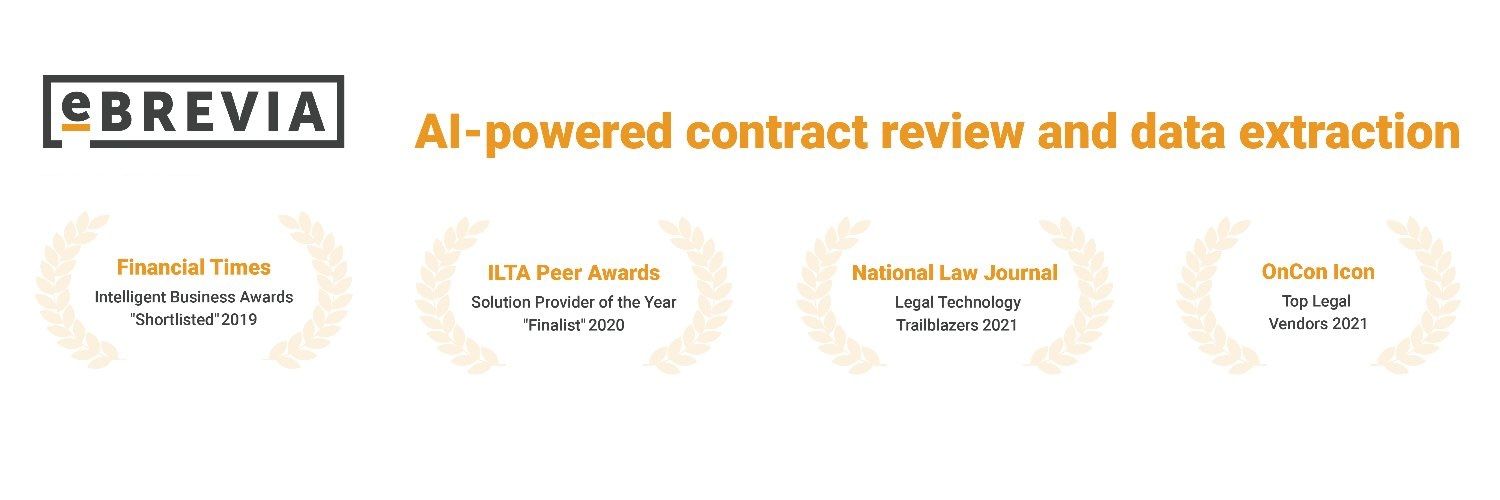
eBrevia: Complete Buyer's Guide
Mid-market AI due diligence platform
eBrevia positions itself as the mid-market AI due diligence platform that enables legal professionals to accelerate contract analysis and document review through self-training artificial intelligence. Acquired by DFIN in 2019, eBrevia serves as a specialized solution for M&A transactions, offering automated clause extraction across 37 languages and customizable AI models that legal teams can train without coding expertise[40][92][62].
Market Position & Maturity
Market Standing
eBrevia occupies a specialized mid-market position in the AI due diligence platform landscape, competing primarily against established leaders like Kira Systems and Luminance while targeting faster deployment timelines and more accessible pricing[9][10][58][73].
Company Maturity
The platform's acquisition by DFIN in 2019 provides financial stability and integration with broader legal technology ecosystems, though this corporate relationship raises questions about long-term product independence and development trajectory[44][76].
Growth Trajectory
Market maturity indicators suggest eBrevia maintains active development with recent generative AI enhancements through Lens functionality, demonstrating continued innovation despite the DFIN acquisition[59][89].
Industry Recognition
Industry recognition includes SOC 2 Type 2 certification for security compliance and documented implementations at notable firms including Baker McKenzie and Norton Rose Fulbright[49][100][40][61].
Longevity Assessment
Long-term viability benefits from DFIN's financial backing and continued product development, though the acquisition structure may limit independent innovation compared to venture-backed competitors[44][76].
Proof of Capabilities
Customer Evidence
Morris, Manning & Martin successfully deployed eBrevia for a billion-dollar M&A transaction, completing a 1,400-document review within one week—a timeline the firm characterized as impossible through manual processes[48][71].
Quantified Outcomes
Baker McKenzie and Norton Rose Fulbright implementations suggest cost reductions in due diligence processes, though specific methodologies for calculating reported 60% savings lack detailed disclosure[49][100].
Case Study Analysis
Morris, Manning & Martin's implementation demonstrates the platform's capability to handle high-volume, time-sensitive transactions while maintaining accuracy standards required for major deals[48][71].
Market Validation
Customer accuracy reports vary across different document types and complexity levels, with users citing high accuracy rates in controlled clause extraction tests[50][53].
Reference Customers
Am Law 100 firm adoptions provide market validation for eBrevia's capabilities at the highest levels of legal practice, though independent verification of claimed savings would strengthen the evidence base.
AI Technology
eBrevia's self-training AI technology represents its core technical differentiator, enabling legal professionals to customize clause detection parameters without coding requirements[40][92].
Architecture
Cloud-native architecture enables rapid deployment timelines of 2-4 weeks compared to traditional on-premise installations requiring months of configuration[58][73].
Primary Competitors
eBrevia competes primarily in the mid-market segment against established leaders Kira Systems and Luminance[9][10][58][73].
Competitive Advantages
Competitive advantages include eBrevia's self-training capability without coding requirements, providing significant value for organizations lacking technical resources[40][92].
Market Positioning
Market positioning as a mid-market solution may constrain enterprise adoption where comprehensive feature sets and proven scalability take precedence.
Win/Loss Scenarios
Win/loss scenarios favor eBrevia for mid-market firms requiring multilingual capabilities and faster deployment timelines, while enterprise organizations with complex integration requirements may prefer Kira or Luminance despite higher implementation complexity[9][10][58][73].
Key Features

Pros & Cons
Use Cases
Integrations
Pricing
Featured In Articles
Comprehensive analysis of AI Due Diligence for Legal/Law Firm AI Tools for Legal/Law Firm AI Tools professionals. Expert evaluation of features, pricing, and implementation.
How We Researched This Guide
About This Guide: This comprehensive analysis is based on extensive competitive intelligence and real-world implementation data from leading AI vendors. StayModern updates this guide quarterly to reflect market developments and vendor performance changes.
140+ verified sources per analysis including official documentation, customer reviews, analyst reports, and industry publications.
- • Vendor documentation & whitepapers
- • Customer testimonials & case studies
- • Third-party analyst assessments
- • Industry benchmarking reports
Standardized assessment framework across 8 key dimensions for objective comparison.
- • Technology capabilities & architecture
- • Market position & customer evidence
- • Implementation experience & support
- • Pricing value & competitive position
Research is refreshed every 90 days to capture market changes and new vendor capabilities.
- • New product releases & features
- • Market positioning changes
- • Customer feedback integration
- • Competitive landscape shifts
Every claim is source-linked with direct citations to original materials for verification.
- • Clickable citation links
- • Original source attribution
- • Date stamps for currency
- • Quality score validation
Analysis follows systematic research protocols with consistent evaluation frameworks.
- • Standardized assessment criteria
- • Multi-source verification process
- • Consistent evaluation methodology
- • Quality assurance protocols
Buyer-focused analysis with transparent methodology and factual accuracy commitment.
- • Objective comparative analysis
- • Transparent research methodology
- • Factual accuracy commitment
- • Continuous quality improvement
Quality Commitment: If you find any inaccuracies in our analysis on this page, please contact us at research@staymodern.ai. We're committed to maintaining the highest standards of research integrity and will investigate and correct any issues promptly.